 "QUANTUM SHOT" #507 "QUANTUM SHOT" #507Link Article is written by Constantine vonHoffman (with Avi Abrams). Constantine vonHoffman is a journalist, sf writer, and alleged humorist; visit his site "Collateral Damage" More ghosts per capita than any continent Does Antarctica have the most ghosts of any continent? On a per capita basis, the answer is yes.  While the South Pole and environs doesn’t have a permanent population, there are on average 2,500 people living there during the year -- approximately 4000 in summer and 1000 incredibly hardy ones in winter (source). While no complete necrologies exists for the Antarctic, at least 268 people have died there since humanity first decided it was a good place to visit. So if the ghosts divvie the work evenly, each one only has to haunt 9.68992 inhabitants. (Some lists of who has died way down south include a certain Mrs. Chippy. I have chosen to leave her out of my calculations as she was a cat and if we include her we have to include penguins and then it’s Katy bar the door.) Antarctica is a very popular place to abandon In addition to having a light work load, Antarctic spirits also have an abundance of residences to choose from thanks to the huge number of ghost towns and other such haunts. For obvious reasons, Antarctica is a very popular place to abandon. Below is a map of places abandoned by just the British on the Antarctic Peninsula.  (image credit: United Kingdom Antarctic Heritage Trust) The most famous and disturbingly well-preserved of these places is the camp built by Robert Scott and his party on Ross Island in 1911. The seaweed-insulated wooden cabin and its outbuildings were supposed to be the team’s shelter when they returned from their attempt to be the first people to visit the South Pole.  (images credit: 1, 2)  Robert Falcon Scott is shown on the top right (photos by John Weaver and Herbert Ponting) Scott and four others -- Edward Wilson, H. R. Bowers, Laurence Oates and Edgar Evans -- set out from the base to reach the pole. They reached it on Jan. 17, 1912 only to find that the Norwegian explorer Roald Amundsen had gotten there weeks before them. All five men died trying to get back to the base camp. The final three – Scott, Wilson and Bowers – were just 11 miles from it when they died.  photos by John Weaver Today this hut can easily be visited as it close to both the US Base at McMurdo or New Zealand's Scott Base. Be warned though, global warming is beginning to take its toll and the 100-year-old seal blubber which had been in deep freeze has begun to smell “quite rancid.” Go here if you would like to support efforts to preserve the huts. Here is the Evans Hut; on the right is the seal blubber... 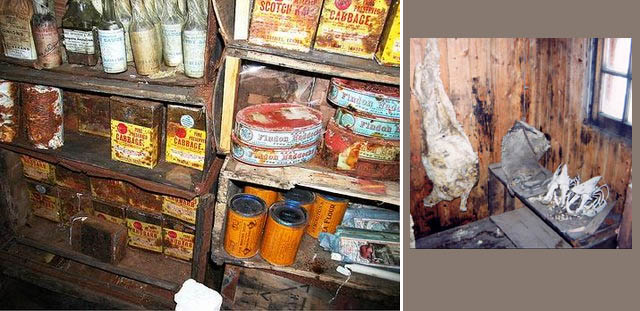 (images credit: 1 and 2) Deception Island is a deceptive place indeed The oldest actual ghost town can be found at Whaler’s Bay on Deception Island. Here is an abandoned Deception base:  (images credit: Lyubomir Ivanov and Sergio Pitamitz) and a Deception hangar -  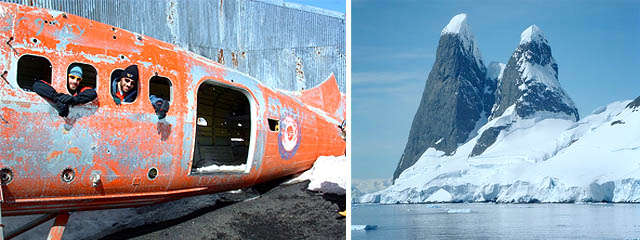 (images credit: David Zaks and Lyubomir Ivanov) In 1906 a Norwegian-Chilean whaling company started using Whalers Bay as a base for a factory ship. Other whaling operations followed suit and a boom town was born. Whalers Bay was abandoned in 1931 following a precipitous decline in the market for whale oil, a result of the Great Depression. 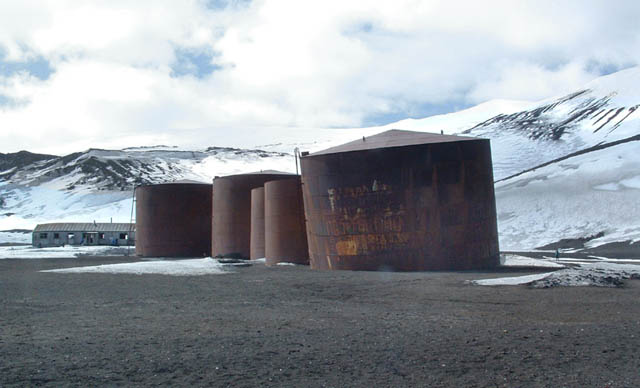 (image credit: David Zaks) Do not be deceived, however. The rest of Deception Island is actually a fairly hopping place. In addition to science bases operated by Spain and Argentina, it is also one of the more popular tourist destinations in the Antarctic. This is probably because (thanks to volcanic activity) the island actually has places where one can be warm.   (images credit: David Zaks) Creepy whaling outposts, left to wither in the winds of time  (image credit: expeditions.com) South Georgia is another Antarctic island that people rushed to abandon. At least seven whaling communities existed there during the first half of the 20th century. When all were up and running the island was estimated to have 2,000 people living on it. Most of the towns are in the process of returning to a state of wilderness but some buildings – notably in the town of Grytviken – have been kept up and are also becoming a tourist destination.  (image credit: Wolfratz) Stromness Harbour boilers and power generators: 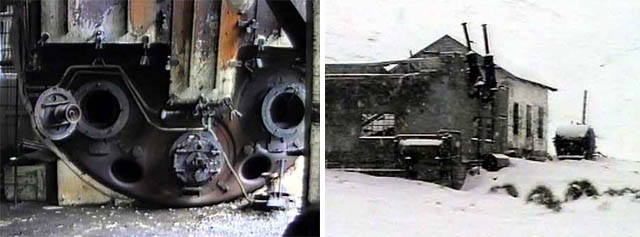 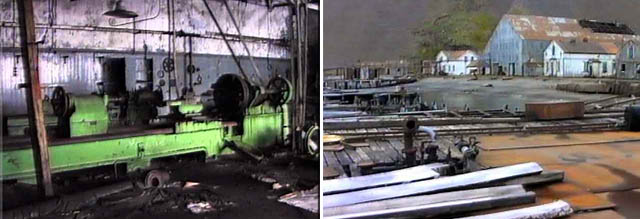 (images credit: mclaren.gs) Portuguese graveyard, and a huge Leith Harbour whaling ghost station:  Grytviken ships "Dias" and "Albatros":  The whaler's cinema... and some old harpoon guns. 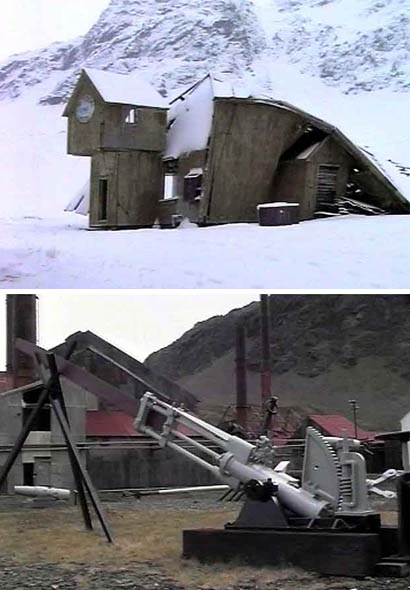 (images credit: mclaren.gs) It is worth noting that these frozen islands have been the subject of heated arguments over who actually owns them – mostly by the UK and Argentina. Deception was initially claimed by the UK and then apparently ceded to the Argentines. South Georgia and the South Shetland islands are still possessed by the UK. The dispute over ownership of South Georgia was a contributing factor in The Falklands War (described by Argentine writer Jorge Louis Borges as “two bald men fighting over a comb”) and was briefly occupied by the Argentines. It is possible wars have been fought over more useless pieces of real estate but none come to mind.  (photos by Richard Harrington) Slicing through the silence... ...the ghastly tall ship arrives. The Almirante Brown Research Station - abandoned by Argentina, awaits in the mist:  (image credit: Scotus) The Real "Mountains of Madness" One other thing that would attract ghosts to Antarctica: It’s the only place on the planet where they have their own mountain range. The Gamburtsevs is a range of mountains practically at the center of the continent which geologists call the "ghost range". Despite being of a size comparable to the Alps they have never been seen by humans, nor is it likely they ever will because they are covered by up to 4km of ice. Researchers are currently seeking to map the mountains using radar and other methods. (more info) And then, there are meteorites bombarding Antarctica (which is considered to be a "meteorite collector" - most of our knowledge about meteorites comes from there) Scientists go out in snowmobiles to hunt for meteorites (kind of like picking mushrooms), spotting and recovering them from the East Antarctic Icesheet: 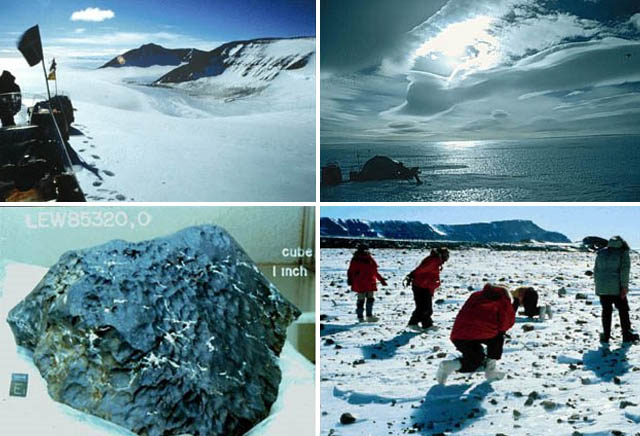 (images credit: The Antarctic Search for Meteorites) Some meteorites arrive from Mars, some come from further reaches of space... All this somehow gets me thinking about unmentionable parasitic alien organisms, so I better stop at this point. Also Read: Dry Valleys of Antarctica Shipwrecks & Sea Disasters Russian Nuclear Icebreakers: To the North Pole!  Permanent Link... Permanent Link... ...+Facebook ...+Facebook Category: Abandoned,Travel |
The Ghosts of Antarctica: Abandoned Stations and Huts
Subscribe to:
Post Comments (Atom)
Check out this stream
Blog Archive
-
▼
2008
(968)
-
▼
December
(47)
- Heroes Coloring Pages
- Cars with Propellers: an Illustrated Overview
- Hilarious & Crazy Signage, Part 12
- Stellar Mystique and Violence
- Flower and Bee Coloring Pages
- Happy Holidays from DRB!
- Mind-Shattering Novels of Philip K. Dick
- Little Mermaid Coloring Pages
- Link Latte 92
- Astounding Japanese Highways, Bridges and Intercha...
- Goose Coloring Pages
- Don't Know Much About... (Awesome Tidbits of Infor...
- Weird Books & Illuminated Manuscripts
- Winnie The Pooh Coloring Pages; With Flower!
- Dora The Explorer Coloring Pages
- Just to Cross the Road...
- Coconut Tree Coloring Pages
- Classic & Pulp SF Update
- Punch Hole Clouds & Other Rarely Seen Cloud Format...
- Link Latte 91
- Winnie The Pooh Coloring Pages
- Dieselpunk: Love Affair with a Machine
- Carnival Coloring Pages
- Little Mermaid Coloring Pages
- Parkour in the 1930s
- The Seven Deadly Sins of Geekdom
- Love Coloring Pages
- Love is Precious Moments Coloring Pages
- Precious Moments Coloring Pages
- The Hungry Dog Story
- Free Kaleidoscope Coloring Pages
- Free Kids Coloring Pages
- The Ghosts of Antarctica: Abandoned Stations and Huts
- Rare Pulp Science Fiction, Issue 3
- Link Latte 90
- Steampunk Art & Gear (DRB Series)
- Spiderman Coloring Page
- Shimizu Megacity Pyramid
- Nemo Coloring Page
- Disney Pincesses
- Happy Family Coloring Page
- "Quantum of Solace" James Bond's Aston Martin DBS
- Archive: November 2008
- The Incredible Mimic Octopus
- Cats Coloring Pages
- Small Wonders: Miniature Palaces & Dollhouses
- Link Latte 89
-
▼
December
(47)









0 comments:
Post a Comment